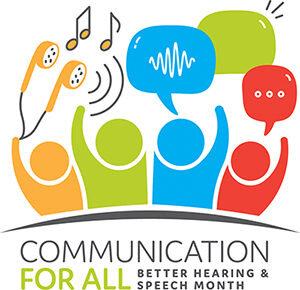Celebrating Better Hearing and Speech Month Because …Communication Works!
graphic for BHSM reads Communication For All (speech)
Much of daily life is centered on communication which involves speech, language and hearing. For those who have delays or challenges in these areas, it can affect the ability to communication and connect and meet basic and essential goals: at school, work, and in relationships. Everyday tasks become frustrating and difficult to manage, and people can easily lose independence and self-esteem.
What’s the Role of a Speech Therapist?
As speech and language pathologists, we are here to help. Most people think of a speech therapist as someone who helps with talking or expressing oneself (articulation and fluency). That is correct but only a part of what we do: Our scope of practice covers all aspects of communication and language development. Did you know that we can help with social engagement, behavior management, nonverbal communication, augmentative communication (e.g., sign language, gestures, computer devices and other technology), comprehension of verbal and written language, writing, and executive functioning? We even work with individuals whose native language is a language other than English and collaborate with bilingual Speech Therapists to evaluate if the individual has a language difference for dialectal influences, or a true disorder across all languages. Much of what we do includes essential academic and life skills like reading, writing, sequencing, and critical thinking.
When to Ask for Our Help or Refer a Child for Services?
Sometimes a child’s challenges in these areas are not detected prior to entering school, when demands increase. It’s important to be aware of the areas where a specialist might be able to help and/or referral for a screening or services is in order. The following are some examples of signs that a child may be facing challenges in the areas of speech, language, and communication:
Difficulty expressing themselves, finding words, or organizing thoughts to convey what they are thinking
Has difficulty with the clarity of speech, or speech sound production
Repeats or gets stuck on sounds, or phrases, words.
Uses non-specific or general words such as “stuff” or “those” to describe things
Uses gestures instead of words to get wants and needs met or convey thoughts
Difficulty following or understanding directions
Difficulty comprehending a story or spoken language, might say “huh” or “what” frequently
Trouble retaining the details or main idea of a story or plan
Long response latencies (i.e., long delay between posed question and answer)
Difficulty with sequencing of letters or numbers, reading, writing and/or spelling
Challenges with staying on topic, initiating and maintaining a conversational
Struggles to make friends, think about others (perspective taking) or understand how their actions affect others
Seems isolated, struggles to work in groups, low self-esteem
picture of kids high-fiving (speech)
Team Approach
These challenges can affect learning and overall academics, the ability to make friends, and self confidence, and they often lead to maladaptive behavior. Teachers have a lot of their plate with classrooms full of different learners. A speech and language therapist not only can provide the needed and additional support for the child (and caregivers) but also to the classroom teacher by providing full class lessons, consultation and strategies for improving communication.
Classroom Strategies
First and foremost, make sure that the student has had a recent hearing assessment
If they struggle to focus and attend during a listening activity, make sure they are seated in an area with the least possible amount of auditory and visual distraction.
Discuss whole body listening: It’s not just the ears that need to hear the information, but the entire body plays a part, and some parts need to be active (e.g., brain, heart, ears) vs. inactive (e.g., mouth, hands, legs, body).
Discuss the expectations for listening and talking in class with added supports such as a social behavior map (link), role play, and priming before each activity starts.
Use visual supports such as graphics, photos, videos, to supplement verbal directions/lectures.
Support multi-sensory sessions to engage all learners.
Keep verbal directions simple, concise, and to the point. Call out when important information is being shared (e.g., “This is important, is everyone listening?” “This will be on the test”; “Are you ready for the next instructions?”)
Encourage peer support and mentoring.
Notice what is going well and call it out. Strive to cultivate a culture of acceptance and take the time build a rapport with the students who might be struggling.


